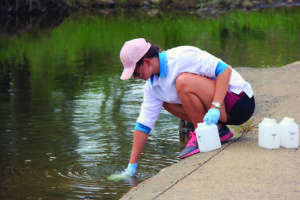15 November 2017
In northern Australia, detecting aquatic species can be difficult, labour-intensive and expensive, due to factors such as remote locations, expansive geographic areas, limited and variable site access, and hazards such as crocodiles. A new Hub research project is therefore developing eDNA technology and trialling field methods to help make surveying as simple as collecting a water sample. Plants and animals shed cells containing their DNA into the rivers and creeks where they live. This is called ‘environmental DNA,’ or eDNA. A water sample from a river contains this eDNA and so gives information about which plants and animals are present in the area. Such information will improve our knowledge of several priority conservation species and pest species in northern Australian and inform development planning processes, impact assessments and management decisions. For more information, see the start-up factsheet or contact Project Leader Professor Damien Burrows.

Surveying for plants and animals may be as simple as collecting a water sample, photo Damien Burrows.
Want to know more about the Resilient Landscapes Hub's activities and our research into practical solutions to environmental problems? Stay informed about activities, research, publications, events and more through the Hub newsletter.